By Lambert Strether of Corrente
Puerto Rico’s road system, devastated by Hurricane Maria, despite being not as newsworthy as its power situation, or providing as many heart-tugging photos[1] — here is a fine write-up from Vox — may in the end prove more intractable.
To begin with, Puerto Rico is almost completely dependent on the automobile for transport. Bloomberg:
Puerto Rico has one of the highest rates of car ownership in the world, thanks to urban sprawl and the government’s failure to build public transportation that commuters might actually use…. Puerto Ricans are isolated without cars… About 931,000 Puerto Ricans drive or carpool to work out of 3.4 million total residents, according to U.S. Census data. … [T]he island has the fifth-highest number of vehicles per capita in the world.
So, a working road system isn’t simply required to get the containers off the docks in San Juan[2], it’s required for every phase of life in Puerto Rico as an economic and social entity (getting to work; taking care of your grandmother). But I found this post a little dispiriting to write, not only because of the suffering I imagined, especially up-country, in the mountains, but because getting basic facts and figures was so hard. I’ll start with one set of figures, then move through maps, then photos, and finally to positive measures that I found being taken (which seem rather small, and ill-coordinated, when set beside the requirements). A lot of this post ultimately depends on assumptions and knowledge about road construction, as well as potential miliary involvement, and I hope readers who have knowledge of either topic will jump in.
Here is the most basic figure of all, from Axios, which I quoted on October 13:
Only 392 miles of Puerto Rico’s 5,073 miles of roads are open
(The Axios post was “updated 19 hours ago” — how I hate this fad of never giving an actual timestamp — as of this writing, and the figure has not changed.) Axios says that its figures come from FEMA and the PR government site, so I went to both places to look. The PR “dashboard” has no figures for roads, so I assume the figure comes from FEMA, and after I clicked the “Expand All Sections” link, there it was, with a key disclaimer not mentioned by Axios or any of the other venues that quoted the figure[3]. As of October 18:
392 miles of Puerto Rico’s 5,073 miles of roads are open, allowing for passage through the outer ring of the island.
(No notes on how that figure was derived; I can imagine some contractor driving round the island on a Humvee, and then writing off the interior entirely). Here is a map from FEMA showing the status of that passable 392 miles of outer ring road:
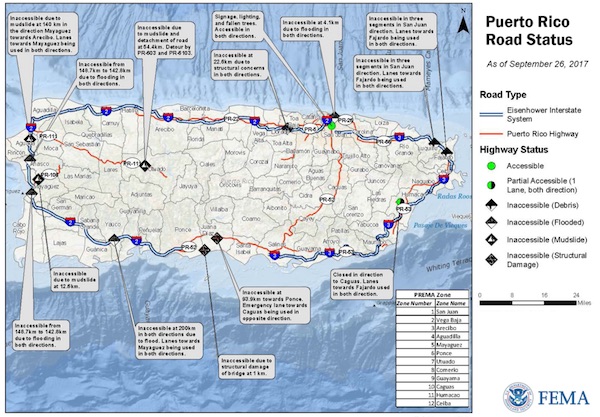
(This is from September 26, but it’s the latest available from on the FEMA site). And here is a map from MapHill showing the remaining 5,073 – 392 = 4681 miles of road:
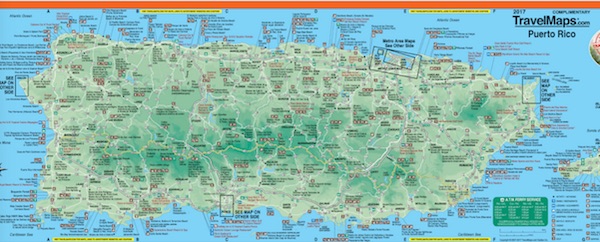
Of course, some of those 4681 miles of road in Puerto Rico will be passable. But we just don’t know how many, which I find, as I said, dispiriting. However, I think we can assume that the damage was uniform, since Hurricane Maria engulfed the entire island:
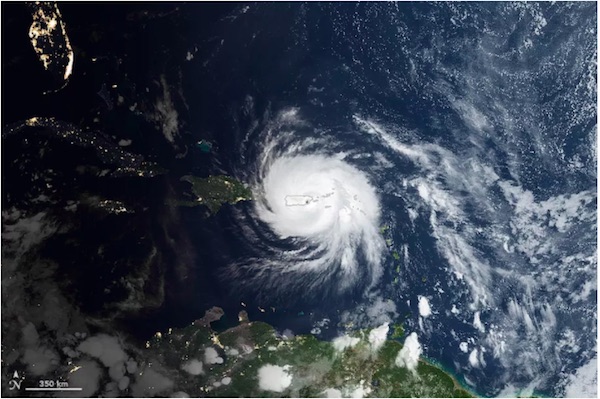
Here are some photos of what roads look like in the interior. First, some wind damage in Toa Alta, west of San Juan:
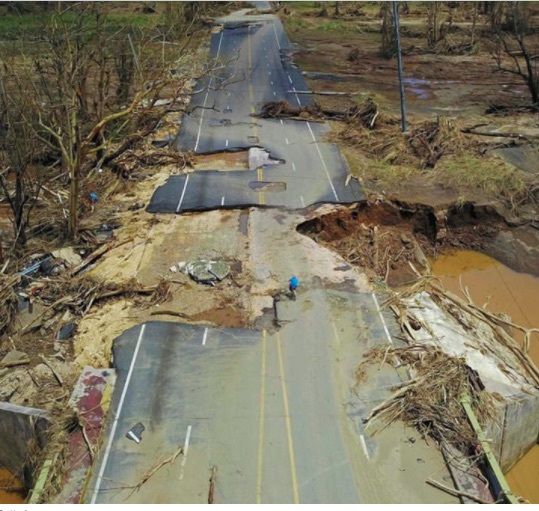
It looks to me like Maria found an exposed edge of tarmac, and lifted it into the air. If indeed the damage is uniform, we can expect a lot of cases like this.
Next, some erosion in Utuado, along the Río Grande de Loíza, the largest river in Puerto Rico by volume:
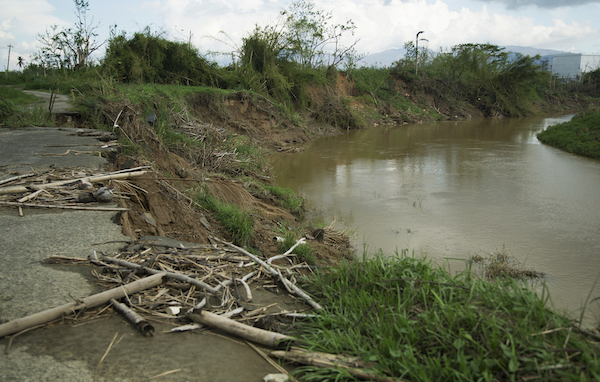
No doubt we can expect a lot of damage like this, along every river and stream.
Finally, washed out roads and mudslides in the mountains, again near Utuado:
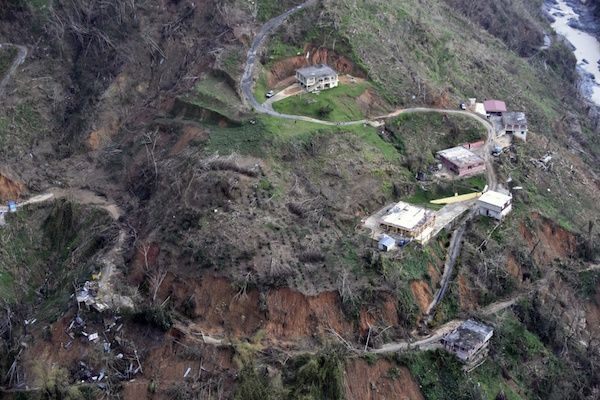
Again, we can expect a lot of damager like this, since Maria engulfed the entire island, and one mountain road is much like another in its vulnerability.
Besides roads, we have bridges. From the Times:
More than 100 bridges in Puerto Rico were damaged by Maria and 18 have been closed indefinitely, according to Ivonne Rosario, a spokeswoman for Puerto Rico’s transportation department. An unknown number collapsed during the storm, leaving entire communities like Charco Abajo stranded.
I don’t understand how this census could be made, given that most roads are impassable. And how is it that 18 have been closed, but an “unknown number” have collapsed?
After this dispiritingly crude approximation of a sitrep, let’s look at some efforts being made. The first is actually encouraging. From the U.S. Forest Service:
If you can hear the speaker over the sound of chainsaws, you’ll hear him say (paraphrasing) that the locals had done a great job clearing the roads of brush and debris. (Of course, they’d need machinery to rebuild the roads, and that’s another matter.)
The second is mildly encouraging, for what it is:
NIAGARA FALLS AIR RESERVE STATION, N.Y. – 125 Soldiers of the New York Army National Guard’s 152nd Engineer Support Company headed for Puerto Rico from the air base on Oct. 18-19, the latest installment in the New York National Guard’s support to the island. The Buffalo, N.Y. based engineers are prepared to conduct debris removal, clear roads, and get lines of communication open, according to Capt. Nathan Attard, the company command.
If we can generalize from the experience of the Forest Service, debris removal and clearing is under control, but getting lines of communication open will be something else entirely, if the wind, erosion, and mudslide damage in the interior is as bad as I think it is:
The Soldiers of the 152nd construct things like roads, airfields and helipads, so his men and woman actually trained in the skills Puerto Rico needs, Attard said. Not only do we do this as Guardsmen but also a lot of us are professional construction workers, he added.
Great! But I’m guessing the scope of the project will require more than 125 soldiers. And more than one team of chainsaw-wielding Forestry Service workers.
According to the Republicans, everything is fine, or as fine as possible. Democrat Schumer has called on Trump to appoint a czar:
Schumer, along with Representatives Nydia Velàzquez and Jose Serrano, said a “CEO of response and recovery” is needed to manage the complex and ongoing federal response in the territory, where millions of Americans remain without power and supplies.
“This person will have the ability to bring all the federal agencies together, cut red tape on the public and private side, help turn the lights back on, get clean water flowing and help bring about recovery for millions of Americans who have gone too long in some of the worst conditions,” he said.
I find Schumer’s call for a CEO dispiriting, too. My first thought was to get the Army Corps of Engineers onto the island, and have them build some roads, but apparently they do waterworks and dams. My second thought was the Seabees (“Construction Battalions”) who do that kind of work.[4] This may not be the best of all possible ideas — although I haven’t heard of private equity pushing Puerto Rican toll roads they would own — but at least I’m, well, trying to deliver a universal concrete material benefit to the people of Puerto Rico. While Trump blusters, all Schumer can do is call for a Man on a White Horse to come up with a plan, he himself having none of his own. The political class seems to have lost the capacity to mobilize on behalf of its citizens (although looting and internecine warfare proceed as normal). This too is dispiriting.
NOTE
[1] I loathe disaster porn. Please don’t hate me.
[2] As of October 19, Crowley Maritime: “Crowley’s Isla Grande Terminal in San Juan continues to experience high volumes of cargo on the terminal, though the dispatch rate is returning to close to the normal rate of 500 per day. The company has reported that increased terminal throughput has reduced the significant backlog resulting from on-island disruptions due to the hurricane, but that additional commercial and relief cargo reaching Puerto Rico is creating ‘unusually high’ loads awaiting dispatch.” I can’t decrypt that to arrive at a figure of how many containers are actually still on the docks, but I take it that there is still a backlog, though it’s not as bad as it was.
[3] FEMA seems to have obfuscated power and water figures, but not, apparently, roads.
[4] Too bad we don’t have a Jobs Guarantee….


The most important things are guaranteed:
Funding the military, enforcing payment of debts, Profit, promises made to campaign contributors, … and of course death and taxes.
Somehow, I think our government’s response to PR/Maria will be the new norm unless there are a bunch of billionaire’s calling the gov reps they bought to complain. And even they may be frustrated by the current boob in the WH.
My dear Lambert, were I a vulture capitalist (which I am not!), I would not put one plugged nickel into infrastructure in PR. Not toll roads, not resorts, not power grid, not rebuilding the pharma factories, nada. Because another Maria will just happen again and trash it all before sufficient ROI, and who’s gonna insure it now? Insurance companies believe in climate change, whether they will admit it or not.
But I would put a few $$$ into PR debt, and gamble that the US govt will bail *me*and my fellow vultures (not PR) out. Am I cynical enough?
The Intercept has a good article on a Puerto Rican recovery for Puerto Ricans and not outside interests.
What about the cars? I would imagin that many cars were distroyed, heavely damaged, or simply lost. Getting cars repaired and replaced will also be a major chalange. And this I bet would fall on the backs of the individual owners who will already be strapped for cash to begin with.
Pretty well, yup. Insurance companies gonna pay pennies on the dollar, assuming you actually have insurance for stuff like thi. Ppoor people tend to get the very minimum needed to get their vehicle on the road, which is usually liability. If you do have bountiful; coverage for Acts O’God, where are you going to get your car repaired or replaced anyway? This may sound super-cynical, even for me, but looking at those washed out and blown-away roads, getting cargo into remote places in PR is a job for sure-footed critters like mules and horses. Dirt bikes can move people over difficult terrain. So can bicycles, and they have been preparing for such a thing.
The crisis in PR compared to the crises in FL and TX really opened my eyes to how dangerous and precarious it must be to live on an island, even one ostensibly connected to a powerful country. The logistical nightmare of getting things there is compounded so much by that sea barrier. At least in TX, you can call in the cajun navy who can drive their boats to the location, then launch.
So now one thing is even clearer to me: the first losers of rising sea levels and climate change disasters will be islanders. Places like the Maldives and the Leewards will have a really hard time in the next few decades.
>is compounded so much by that sea barrier.
??? The sea is how people got things everywhere long, long before the first steam engine (and I’m talking those Roman toy ones) was even conceived?
This is just incompetence. Load up cargo ships (which are the most enormous transportation devices on the planet) and bring an aircraft carrier or two with cargo helicopters to bring the goods inland:
“The CH-53E heavylift transport helicopter …can carry cargo with a maximum weight of 13.6 t internally or 14.5 t externally.”
But yes, agree on the precarity of island life.
I get what both of you are saying vis a vis sea travel, Jones Act and all, but even in the best of all possible human organizations, it’s still a major factor in any relief effort. It’s just not nearly as easy to get people from point A to point B by boat. If your car breaks down, you’re stranded, if your boat breaks down, you could easily die.
Much of the sea barrier is man-made, namely the Jones Act. As a result, it is more expensive for Puerto Rico to get supplies form the US than from non-American sources because of shipping costs.
Could NC do a post on the Jones Act?
Do we allow foreign-flagged vessels to transport goods between, say, California and Hawaii? What about Guam and the US Virgin Islands?
We do live on a global island. Soot from Chinese coal burning lands on the few remaining glaciers in Glacier National Park and hastens their demise. Methane from melting permafrost in the Northwest Territories acts as a blanket to increase solar heating of the ocean surface. Increased ocean temperatures help hurricanes to explode from Category 1 to 5 almost overnight and stall over Houston as a Biblical deluge.
Three well-placed air-burst EMP nuclear bombs can disable communication and transport over most of the country. And a week without water and food being transported into New York would turn it into San Juan with no rescue boats on the horizon and frozen corpses piling up in the alleys in mid-winter.
We all live on an island—one held together by a thin spider web of technology and resting upon an biosphere that we are waging war against with our insatiable imperative of growth.
“The political class seems to have lost the ability to mobilize on behalf of its citizens.”. It wasn’t always this way. Read http://northernwoodlands.org/articles/article/thirty-eight-new-england-lumber-storm.
When I read what the FDR Administration was able to accomplish amidst the devastation of New England’s forests wrought by the hurricane of 1938, it brought tears to my eyes.
“The political class seems to have lost the ability to mobilize on behalf of its citizens.”
My momma used to say, “Where there’s a will, there’s a way.” I have observed that if there’s ‘no way’, it’s because there is no will. I think this is the case in PR, as it was in NOLA, and as it seems to be in Houston (except for the *nice* neighbourhoods, of course). Cali fire victims, prepare to be On Your Own(tm).
Great job, Lambert….insight and solid research into a topic overlooked by the MSM and the politicals….
If your intesrest and time permits, I would love a report on what FEMA will/has provided for LONG TERM HOUSING for PR, Northern CA, and the areas hit hard by hurricanes on the USA mainland…..
I have not been able to locate much on this topic…
Last I heard was that FEMA had Zero trailers on hand and had let out a contract to some company(s) to build new trailers.
In the interim, there was a report that FEMA would be distributing TENTS to some people in need of shelter. I believe this article was a report from Florida after the fist Hurricane hit there.
A look at Puerto Rico shows that there at lots of homes without roofs…..and they are probably not accessible for a trailer delivery up in the hills. In Santa Rosa, CA, there is very little affordable and available housing close to Santa Rosa. The rains will arrive and then the Mud will Turn the Sand into YUCK and MUCK.
I remember, after Katrina and her friends beat up New Orleans, a lot of folks were flown away from New Orleans (Barbara Bush opined it was probably a good deal for a lot of ’em) and many did not return. Others were put in FEMA trailers. (TREME on HBO covered the KATRINA aftermath as only David Simon can!)
Anyone else, who can provide me with links or information, is most welcome to respond.
Happy Trails,
JohnS
FEMA’s mission is emergency/first response mobilization. It is not their job or within its functionality or budget to provide long-term rebuilding solutions. That falls on the island’s government, with congressional financial assistance if congress allocates money for it.
The Army Corps of Engineers are one thing, the other things are the Combat Engineers, organized perhaps as regiments and assigned to combat brigades. These are the people who do roads, airfields, etc., and the ones you would have wanted on the spot in Puerto Rico from maybe day two.
I strongly believe the problem is the deployment to the Middle East. Bullies strongly believe they must never, ever show weakness. So they believe that they can’t pull Combat Engineers out of Whateveristan without looking weak.
So they don’t – and they bless their lucky stars that Puerto Rico isn’t a state and Puerto Ricans aren’t considered Americans by most Americans. However – how many of those deployed to the ME are from Puerto Rico, and how are they reacting? I gotta wonder.
USGS has started mapping the landslide impacts:
https://landslides.usgs.gov/research/featured/2017-maria-pr/
http://blogs.agu.org/landslideblog/2017/10/05/hurricane-maria-1/
To get a road open, you need to clear the trees and debris, repair bridges, and repair landslides. In rugged terrain, this is a serious effort as just one break makes the road unusable for deliveries beyond the break.
The Bloomberg piece explains:
The only thing I would like to mention is that people don’t drive because there soley because there is no public transportation, they drive because it is the most convenient/fast/cost effective mode of travel available. You could build all the lightrail in the world, but if it wasn’t more convenient/cheaper/cost effective than driving, people wouldn’t take it. Disincentives for driving are much more powerful than incentives for transit.
How much road do they have per inhabitant there? Maybe disasters like these could be a wakeup call for how we lay out our development and where we spend our infrastructure dollars? Unfortunately probably not.
I haven’t read the book or seen the movie, so maybe my comment is off base, but I’ll proceed anyway. This article makes me think of the post-apocalyptic drama “The Road”, by Cormac McCarthy.
If the U.S. is not an empire, Puerto Rico would not be a protectorate or whatever. If the U.S. is an empire in decline, Puerto Rico being abandoned would be a signal to the world that the U.S. dollar is in serious trouble.
What with PR’s situation and the apparent U.S. tendency to retreat from simple truths, could a collapse in preference falsification* be in progress?
From my side of the world, the U.S. is becoming more than ever a busted flush of apparent and unsustainable inconsistencies which might take us all down with it.
Here’s hoping that there is a bounty of brilliant minds and and excellent administrators in the U.S. military leadership who are ready to step up.
Pip Pip!
*see Timur Kuran’s 1995 work.
By report Puerto Rico is making a deal with a Washington (state) power company on power line repair, the issues involved in running power lines through PR and through inland Washington being rather similar. the last Saffir 3, 4, or 5 hurricanes ot hit the island did so in 1928 and 1932, or so I hjave read, so on one hand there is plenty of time to get a return on investment, and on the other hand, there was no rationale for building power lines that could survive a force 4 or 5 hurricane.
Puerto Rico is third world lite. They could rebuild and become a model for the third world. There are only 3 million people on the island. They dont have to pay Fed income tax. It could be a great retirement location for elderly whites. It just requires investment. Currently the single largest employer is the US govt. They need leadership from within.
Here’s what the IRS says about Puerto Rico and income taxes (quoted from Wikipedia):
So they pay income tax, but only on income from outside Puerto Rico. Also from Wikipedia: